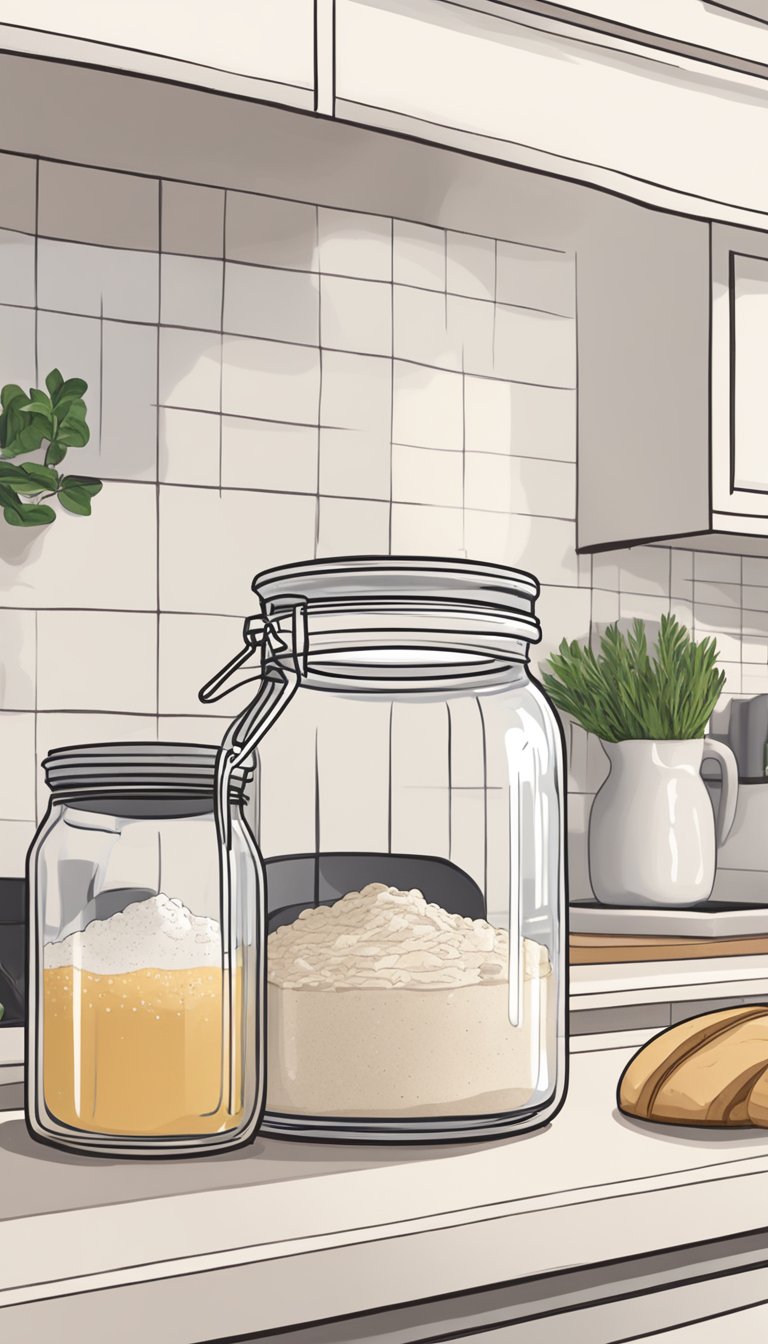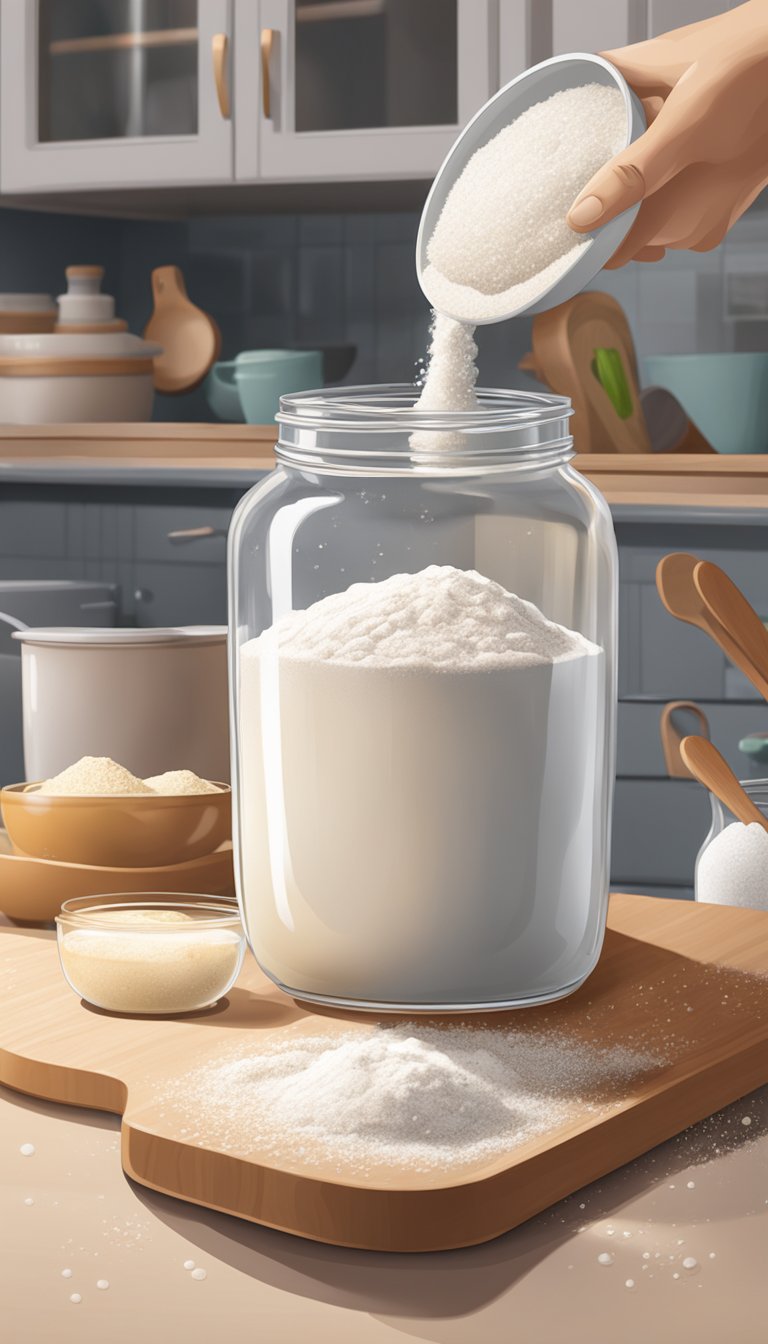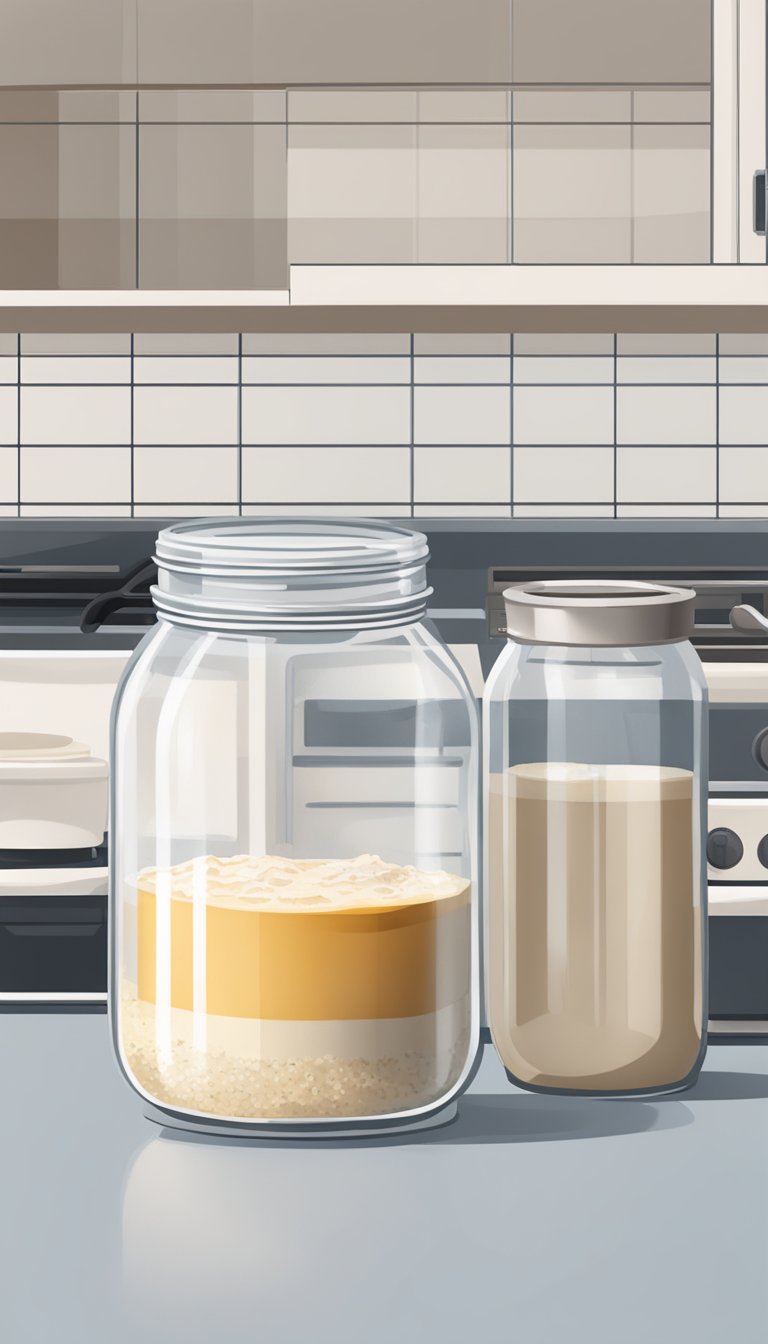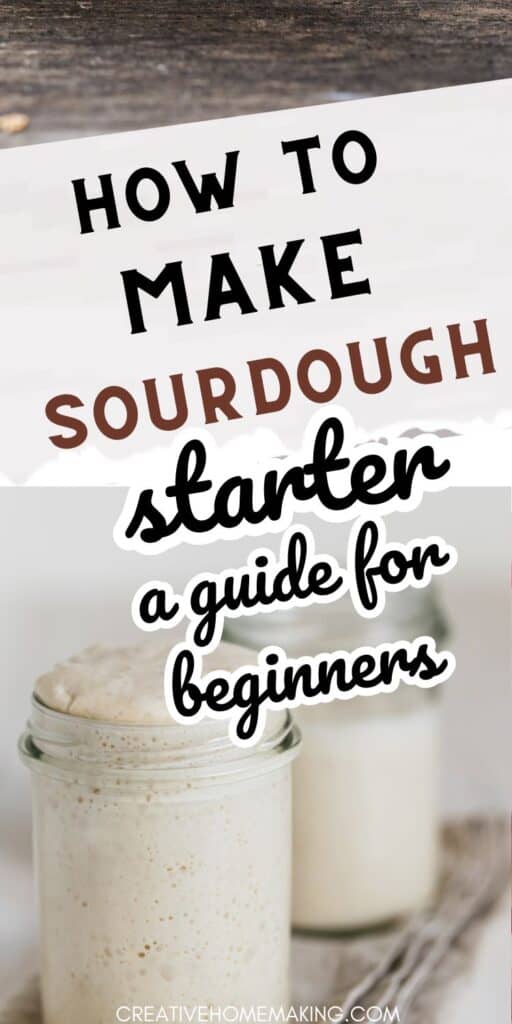Sourdough bread has gained immense popularity in recent years due to its unique flavor and texture. One of the essential ingredients in making sourdough bread is the sourdough starter. A sourdough starter is a mixture of flour and water that has been fermented by wild yeast and bacteria. It is the backbone of sourdough bread and gives it its characteristic tangy flavor.
This post may contain affiliate links.
For beginners, making a sourdough starter from scratch can seem intimidating, but it is a straightforward process that requires only a few ingredients and some patience. In this article, we will guide beginners through the process of making a sourdough starter step-by-step. We will cover everything from the ingredients needed to maintaining the starter once it is established. By the end of this article, you will have a solid understanding of how to create and care for a sourdough starter and be well on your way to baking delicious sourdough bread at home.
Related Article: Quick Sourdough Pizza Dough: A Delicious and Easy Recipe
Understanding Sourdough Starter
What Is Sourdough Starter?
Sourdough starter is a fermented culture made from flour and water that serves as a natural leavening agent in bread-making. It is a mixture of wild yeast and bacteria that work together to break down the carbohydrates in flour, producing carbon dioxide gas which causes the dough to rise.
Related Article: No Knead Dill Rye Bread

The Role of Wild Yeast and Bacteria
Wild yeast and bacteria are the two main microorganisms present in sourdough starter. The yeast is responsible for the leavening of the dough, while the bacteria produce lactic acid which gives sourdough its characteristic tangy flavor. The balance between the yeast and bacteria in the starter is crucial to the final flavor and texture of the bread.
The Science of Fermentation
Fermentation is the process by which the yeast and bacteria in the sourdough starter break down the carbohydrates in flour, producing carbon dioxide gas and other byproducts. This process takes time, typically several hours or even days, and requires a warm and humid environment. The longer the dough ferments, the more complex the flavors will be.
Related Article: The Best Way to Freeze Bread
To maintain a healthy sourdough starter, it is important to feed it regularly with fresh flour and water, and to keep it at the right temperature. With a little bit of patience and practice, anyone can learn to make delicious sourdough bread using a natural, fermented culture.
Creating Your Starter

Creating a sourdough starter from scratch can seem daunting, but it’s actually quite simple. All you need is flour, water, and patience. Here are the steps to follow:
Choosing Your Flour
The type of flour you use will affect the flavor and texture of your sourdough bread. All-purpose flour, whole wheat flour, bread flour, and rye flour are all good options. You can use a single type of flour or a combination of different flours. It’s best to use fresh flour that hasn’t been sitting in your pantry for too long.
Related Article: Traditional Irish Soda Bread Recipe
Mixing Flour and Water
To create your starter, mix equal parts flour and water in a clean jar or container. Use a wooden spoon or your hands to mix the flour and water until there are no dry spots. Cover the jar with a breathable cloth, like cheesecloth or a coffee filter, and secure it with a rubber band.
The First Few Days: What to Expect
For the first few days, your starter may not seem like it’s doing much. That’s normal. You may see some bubbles and a slightly sour smell. This means that the natural yeast and bacteria in the flour and air are starting to ferment. You’ll need to feed your starter every day by discarding half of it and adding fresh flour and water. This will help the yeast and bacteria grow and develop.
After a few days, you should start to see more activity in your starter. It may double in size and have a stronger sour smell. This means that your starter is maturing and becoming stronger. Keep feeding it every day and it will be ready to use in your sourdough bread recipe in about a week.
Related Article: Easy Sourdough Bread Dutch Oven Recipe
Feeding and Maintaining Your Starter
Starting a sourdough starter is easy, but maintaining it can be a bit tricky. Feeding and maintaining your starter is essential to keep it healthy and active. Here are some tips on how to feed and maintain your starter.
Feeding Schedule and Ratios
Feeding your starter is all about maintaining a balance between the yeast and bacteria in the culture. The feeding schedule and ratios depend on your personal preference and the environment you are in. A 1:1 ratio of starter to flour and water is a good starting point for most beginners. This means that for every 100g of starter, you add 100g of flour and 100g of water. You can adjust the ratio as needed based on the activity of your starter.
Related Article: Sourdough Bread for Beginners: A Simple Guide to Get You Started
Most bakers feed their starter once or twice a day. However, this can vary depending on the temperature and activity of your starter. If you keep your starter at room temperature, you may need to feed it more often than if you keep it in the refrigerator.

Understanding When to Feed
It’s important to understand when to feed your starter. You should feed your starter when it’s at its peak activity, which is usually 4-6 hours after feeding. You can tell when your starter is ready to be fed by looking for these signs:
- Bubbles on the surface of the starter
- A sweet, slightly sour smell
- The starter has doubled in size
If you miss the peak activity, don’t worry. You can still feed your starter, but it may take longer to become active again.
Related Article: Quick Sourdough Discard Recipes
Maintaining Starter at Room Temperature vs. Refrigerator
You can maintain your starter at room temperature or in the refrigerator. Keeping your starter at room temperature will make it more active, but you will need to feed it more often. If you keep your starter in the refrigerator, you can feed it less often, but it will take longer to become active again.
If you plan on baking regularly, it’s best to maintain your starter at room temperature. However, if you don’t plan on baking for a while, you can keep your starter in the refrigerator and feed it once a week.
Related Article: One Hour Dinner Rolls
Troubleshooting Common Issues
Sourdough starter can be tricky to work with, especially for beginners. Here are some common issues that may arise and how to troubleshoot them.
When Your Starter Isn’t Rising
If your sourdough starter isn’t rising, there are a few things you can try. First, make sure that you’re using the right type of flour. Sourdough starter works best with whole grain flours, as they contain more nutrients and natural yeasts. Additionally, make sure that your starter is being kept in a warm, draft-free environment. If the temperature is too low, the yeast won’t be as active.
If your starter still isn’t rising, you may need to discard some of it and start over. This can happen if the starter becomes contaminated with bad bacteria or if it’s not being fed often enough.
Related Article: Sourdough Discard Coffeecake
Dealing with Unpleasant Smells
Sourdough starter can have a strong, tangy smell, but if it smells unpleasant or rotten, there may be a problem. This can happen if the starter is contaminated with bad bacteria or if it’s not being fed often enough. To fix this issue, try discarding some of the starter and feeding it more frequently. You can also try using filtered water instead of tap water, as tap water can contain chlorine that can kill off the natural yeasts in the starter.
Related Article: Sourdough Discard Blueberry Muffins
The Presence of Hooch
Hooch is a thin, grayish liquid that can form on top of sourdough starter if it’s not being fed often enough. This can happen if the starter is being kept in a cold environment or if it’s not being fed enough flour. To fix this issue, simply discard the hooch and feed the starter more frequently. You can also try adding more flour to the starter to thicken it up.
Baking With Sourdough Starter
Sourdough starter is not just a great way to make bread, but it can also be used in a variety of other recipes. Here are some tips and tricks for baking with sourdough starter.
Preparing the Starter for Baking
Before using the sourdough starter in a recipe, it is important to make sure it is active and ready to use. This can be done by feeding the starter with equal parts flour and water and letting it sit at room temperature for several hours or overnight. The starter should become bubbly and active, indicating that the yeast is alive and ready to leaven the bread.
Sourdough Bread Basics
Sourdough bread is a classic recipe that can be made with just a few simple ingredients: flour, water, salt, and of course, sourdough starter. The starter is used to leaven the bread, giving it a unique flavor and texture. It is important to follow a recipe closely when making sourdough bread, as the ratios of ingredients and the timing of each step can greatly affect the final result.
Exploring Other Recipes with Sourdough Discard
When feeding the sourdough starter, there is often a small amount of discard that can be used in other recipes. This discard still contains live yeast and can be used to add flavor and texture to a variety of dishes. Some popular recipes to try with sourdough discard include pizza crust, pancakes, and pretzels.
Caring for Your Sourdough Starter Long-Term
Caring for your sourdough starter long-term is crucial to ensure that it remains healthy and active. Here are some tips to help you keep your starter in top shape for years to come.
Long-Term Storage Solutions
If you plan on storing your sourdough starter for an extended period, it’s important to choose the right container. Mason jars and stainless steel containers are both excellent options as they are airtight and won’t react with the acidic nature of the starter.
To store your starter long-term, you’ll need to reduce the amount of food it receives. Feed your starter as usual, then discard all but a small amount and transfer it to a clean container. Cover the container, and store it in the fridge. You can leave it for up to a month without feeding it, but it’s best to refresh it every couple of weeks to keep it active.
Sharing and Gifting Starter
Sharing your sourdough starter is a great way to introduce others to the world of sourdough baking. To share your starter, simply transfer a small amount to a clean container and feed it as usual. Once it’s active, you can give it to a friend along with instructions on how to care for it.
When gifting a starter, it’s important to make sure that it’s active and healthy. Give your friend a small amount of the starter along with detailed instructions on how to feed and care for it. They’ll need to feed it regularly to keep it active and healthy.
Reviving a Neglected Starter
If you’ve neglected your sourdough starter, don’t worry – it’s not too late to revive it. Start by discarding all but a small amount of the starter and feeding it as usual. If it doesn’t show signs of life after a few feedings, try adding a small amount of commercial yeast to jumpstart the fermentation process.
It’s important to note that a neglected starter may take a few feedings to become active again. Be patient and persistent, and your starter should be back to its former glory in no time.
Understanding Your Sourdough Starter’s Environment
When it comes to creating a successful sourdough starter, understanding its environment is crucial. The environment affects the growth and activity of the yeast and bacteria in the starter, which in turn affects the quality of the bread. Here are some key factors to consider:
The Impact of Temperature and Humidity
Temperature and humidity play a significant role in the growth and activity of the yeast and bacteria in the sourdough starter. Ideally, the starter should be kept in a warm spot with a consistent temperature between 70°F and 85°F. If the temperature is too low, the starter will grow slowly, and if it’s too high, the starter can become too active and produce acidic flavors.
Humidity is also important, as a dry environment can cause the starter to dry out and form a crust, while a humid environment can lead to mold growth. It’s recommended to keep the starter in a moderately humid environment, around 70% humidity.
Choosing the Right Container and Location
Choosing the right container and location for the sourdough starter is also important. A container that allows for airflow and is easy to clean is ideal. Glass jars or plastic containers with loose-fitting lids work well.
The location of the starter is also crucial. It’s best to keep the starter on the counter, where it’s easily accessible and can be monitored regularly. Avoid storing the starter in the fridge, as this can slow down its growth and activity.
Water Quality and Its Effects
Water quality can also impact the growth and activity of the yeast and bacteria in the sourdough starter. Tap water is fine to use, but if it’s heavily chlorinated, it can harm the starter. It’s recommended to use unchlorinated water or to let tap water sit out for 24 hours before using it for the starter.
Frequently Asked Questions
How do you create a sourdough starter from scratch?
To create a sourdough starter from scratch, you will need flour and water. Mix equal parts of flour and water in a container and let it sit at room temperature for a day. After a day, discard half of the mixture and feed it with fresh flour and water. Repeat this process for several days until your starter becomes active and bubbly.
What is the best type of flour to use for a sourdough starter?
The best type of flour to use for a sourdough starter is unbleached all-purpose flour or whole wheat flour. Avoid using self-rising flour or flour that contains additives or preservatives.
Can I use commercial yeast to jumpstart my sourdough starter?
While it is possible to use commercial yeast to jumpstart your sourdough starter, it is not recommended. The goal of creating a sourdough starter is to cultivate wild yeast and bacteria naturally present in the flour and environment.
What kind of container should I use to keep my sourdough starter?
You can use a glass jar or a plastic container with a lid to keep your sourdough starter. Avoid using metal containers as they can react with the acidic nature of the starter.
How long does it typically take to establish a healthy sourdough starter?
It typically takes 7-10 days to establish a healthy sourdough starter. However, this can vary depending on the temperature and humidity of your environment.
What are some tips for maintaining a vigorous and active sourdough starter?
To maintain a vigorous and active sourdough starter, it is important to feed it regularly with fresh flour and water, keep it at room temperature, and discard half of the mixture before each feeding. You can also experiment with different feeding schedules and flour types to find what works best for your starter.
Follow my sourdough recipes board on Pinterest.



